Valery Polyakov, record-setting cosmonaut, dies
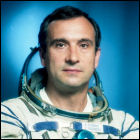 The cosmonaut who still holds the record for the longest single stay in space, Dr. Valery Polyakov, dies at the age of 80. Born in 1942, Polyakov joined the cosmonaut corps in 1972, and then had to wait sixteen years for his first flight, aboard Soyuz TM-6 to the Mir space station in 1988, where he stayed for 240 days. In January 1994 he returned to Mir aboard the Soyuz TM-18 mission, and remained in orbit for a continuous 437 day stay, still the longest continuous spaceflight undertaken by a human being at the time of his death. He returned to Earth in March 1995 and retired from the active cosmonaut rotation a few months later, remaining with the post-Soviet Russian space program as an advisor in the area of the health effects of long-term spaceflight, as well as having a hand in selecting future cosmonauts. He was awarded both the Hero of the Soviet Union and the Hero of the Russian Federation over the course of his career. Though fellow cosmonaut Sergei Adveyev holds the record for the most time in space, that time was accumulated over the course of three missions; as of 2022, Polyakov’s single-flight record remains unbroken.
The cosmonaut who still holds the record for the longest single stay in space, Dr. Valery Polyakov, dies at the age of 80. Born in 1942, Polyakov joined the cosmonaut corps in 1972, and then had to wait sixteen years for his first flight, aboard Soyuz TM-6 to the Mir space station in 1988, where he stayed for 240 days. In January 1994 he returned to Mir aboard the Soyuz TM-18 mission, and remained in orbit for a continuous 437 day stay, still the longest continuous spaceflight undertaken by a human being at the time of his death. He returned to Earth in March 1995 and retired from the active cosmonaut rotation a few months later, remaining with the post-Soviet Russian space program as an advisor in the area of the health effects of long-term spaceflight, as well as having a hand in selecting future cosmonauts. He was awarded both the Hero of the Soviet Union and the Hero of the Russian Federation over the course of his career. Though fellow cosmonaut Sergei Adveyev holds the record for the most time in space, that time was accumulated over the course of three missions; as of 2022, Polyakov’s single-flight record remains unbroken.
Soyuz MS-19
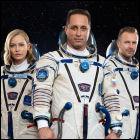 Soyuz MS-19 is launched to the International Space Station from Baikonur Cosmodrome, carrying a three-person crew (the first all-Russian Soyuz crew since Soyuz TM-30 in 2000) to a brief stay aboard the International Space Station. Cosmonaut Anton Shkaplerov, a veteran of three previous flights, commands and pilots the mission, whose other crewmembers, film director Klim Shipenko and actress Yulia Peresild, are passengers visiting the station to shoot approximately 40 minutes of footage for a movie to be released at a later date. The revival of “space tourism” aboard the ISS sparks new controversy about the topic, particularly within the Russian space program, mirroring similar controversy surrounding the burgeoning suborbital passenger spaceflight industry. Shipenko and Peresild return to Earth after 12 days aboard the ISS, catching a ride home aboard Soyuz MS-18 alongside returning ISS Commander Oleg Novitskiy; Shkaplerov remains aboard the ISS to assume command. Soyuz MS-19 will return the current ISS crew to Earth in March 2022.
Soyuz MS-19 is launched to the International Space Station from Baikonur Cosmodrome, carrying a three-person crew (the first all-Russian Soyuz crew since Soyuz TM-30 in 2000) to a brief stay aboard the International Space Station. Cosmonaut Anton Shkaplerov, a veteran of three previous flights, commands and pilots the mission, whose other crewmembers, film director Klim Shipenko and actress Yulia Peresild, are passengers visiting the station to shoot approximately 40 minutes of footage for a movie to be released at a later date. The revival of “space tourism” aboard the ISS sparks new controversy about the topic, particularly within the Russian space program, mirroring similar controversy surrounding the burgeoning suborbital passenger spaceflight industry. Shipenko and Peresild return to Earth after 12 days aboard the ISS, catching a ride home aboard Soyuz MS-18 alongside returning ISS Commander Oleg Novitskiy; Shkaplerov remains aboard the ISS to assume command. Soyuz MS-19 will return the current ISS crew to Earth in March 2022.
Soyuz MS-02
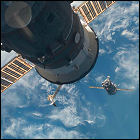 The second uprated Soyuz MS vehicle is launched from Baikonur Cosmodrome. The crew of Soyuz MS-02 are International Space Station Expedition 49 crew members Sergey Ryzhikov, Andrei Borisenko, and Shane Kimbrough; these three will become the Expedition 50 crew in November, and will return to Earth in February 2017 aboard the same vehicle.
The second uprated Soyuz MS vehicle is launched from Baikonur Cosmodrome. The crew of Soyuz MS-02 are International Space Station Expedition 49 crew members Sergey Ryzhikov, Andrei Borisenko, and Shane Kimbrough; these three will become the Expedition 50 crew in November, and will return to Earth in February 2017 aboard the same vehicle.
Soyuz TMA-17M
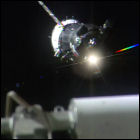 Russia launches three international crew members to the International Space Station aboard Soyuz TMA-17M. Upon reaching orbit, cosmonaut Oleg Kononenko and astronauts Kjell Lindgren and Kimiya Yui discover their spacecraft has a familiar problem: one of the Soyuz solar panel “wings” has failed to extend. As the vehicle is on a five-and-a-half-hour fast-track trajectory to the station, the mission continues and the Soyuz docks at the ISS without incident. After docking, the stuck solar panels extend fully, as happened in 2014’s Soyuz TMA-14M mission. The new visitors to the station will spend four months as part of the Expedition 44 crew.
Russia launches three international crew members to the International Space Station aboard Soyuz TMA-17M. Upon reaching orbit, cosmonaut Oleg Kononenko and astronauts Kjell Lindgren and Kimiya Yui discover their spacecraft has a familiar problem: one of the Soyuz solar panel “wings” has failed to extend. As the vehicle is on a five-and-a-half-hour fast-track trajectory to the station, the mission continues and the Soyuz docks at the ISS without incident. After docking, the stuck solar panels extend fully, as happened in 2014’s Soyuz TMA-14M mission. The new visitors to the station will spend four months as part of the Expedition 44 crew.
Soyuz TMA-14M / ISS Expedition 40
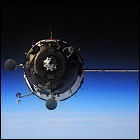 Part of the 40th full-time crew of the International Space Station lifts off from Russia’s Baikonur Cosmodrome aboard Soyuz TMA-14M. Upon arriving in orbit, one of the Soyuz solar panel “wings” fails to deploy, only unfolding properly once the vehicle has docked at the ISS. Aleksandr Samokutyayev, Yelena Serova and Barry Wilmore take up residence on the ISS, becoming part of the Expedition 40 and 41 crews. This crew returns to Earth in March 2015 aboard the same vehicle.
Part of the 40th full-time crew of the International Space Station lifts off from Russia’s Baikonur Cosmodrome aboard Soyuz TMA-14M. Upon arriving in orbit, one of the Soyuz solar panel “wings” fails to deploy, only unfolding properly once the vehicle has docked at the ISS. Aleksandr Samokutyayev, Yelena Serova and Barry Wilmore take up residence on the ISS, becoming part of the Expedition 40 and 41 crews. This crew returns to Earth in March 2015 aboard the same vehicle.
Soyuz TMA-13M / ISS Expedition 40
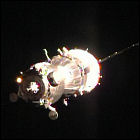 The 122nd Soyuz vehicle launched, Soyuz TMA-13M, lifts off from Russia to the International Space Station, carrying the station’s 40th crew to its stay in orbit. Aboard are flight engineers Maksim Surayev, Greg Wiseman and Alexander Gerst; of the three, only Surayev has previous spaceflight experience, and he will become the ISS Commander upon the departure of Expedition 39. Expedition 40’s stay aboard the ISS is slated to last six months, and Soyuz TMA-13M will be used as a return vehicle by the crew of Expedition 41 later in 2014. Though Soyuz TMA-13M was intended to use the recently developed six-hour fast-track launch trajectory to reach the station the same day it launched, technical glitches delayed its arrival at the ISS until May 28th.
The 122nd Soyuz vehicle launched, Soyuz TMA-13M, lifts off from Russia to the International Space Station, carrying the station’s 40th crew to its stay in orbit. Aboard are flight engineers Maksim Surayev, Greg Wiseman and Alexander Gerst; of the three, only Surayev has previous spaceflight experience, and he will become the ISS Commander upon the departure of Expedition 39. Expedition 40’s stay aboard the ISS is slated to last six months, and Soyuz TMA-13M will be used as a return vehicle by the crew of Expedition 41 later in 2014. Though Soyuz TMA-13M was intended to use the recently developed six-hour fast-track launch trajectory to reach the station the same day it launched, technical glitches delayed its arrival at the ISS until May 28th.
Soyuz TMA-12M
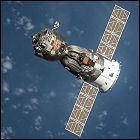 Part of the 39th full-time crew of the International Space Station lifts off from Russia’s Baikonur Cosmodrome aboard Soyuz TMA-12M. Aleksandr Skvortsov, Oleg Artemyev and Steven Swanson take up residence on the ISS for 169 days, becoming part of the Expedition 39 and 40 crews. This crew returns to Earth in September 2014 aboard the same vehicle.
Part of the 39th full-time crew of the International Space Station lifts off from Russia’s Baikonur Cosmodrome aboard Soyuz TMA-12M. Aleksandr Skvortsov, Oleg Artemyev and Steven Swanson take up residence on the ISS for 169 days, becoming part of the Expedition 39 and 40 crews. This crew returns to Earth in September 2014 aboard the same vehicle.
Soyuz TMA-11M / ISS Expedition 38
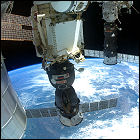 Soyuz TMA-11M is launched from Russia, on a fast-track trajectory to the International Space Station. The crew – Mikhail Tyurin, Rick Mastracchio and Koichi Wakata – arrives just six hours after liftoff. Each of the crew has been in space on at least three prior missions. Also aboard the Soyuz is the Olympic torch, on its own first visit to space; the torch, along with the Expedition 37 crew, returns to Earth in May 2014. Though Soyuz vehicles are usually handed off to the next returning crew, Soyuz TMA-11M returns to Earth with the same crew after a six-month stay. This mission marked the first time the International Space Station was crewed by nine people simultaneously since the end of the Space Shuttle era.
Soyuz TMA-11M is launched from Russia, on a fast-track trajectory to the International Space Station. The crew – Mikhail Tyurin, Rick Mastracchio and Koichi Wakata – arrives just six hours after liftoff. Each of the crew has been in space on at least three prior missions. Also aboard the Soyuz is the Olympic torch, on its own first visit to space; the torch, along with the Expedition 37 crew, returns to Earth in May 2014. Though Soyuz vehicles are usually handed off to the next returning crew, Soyuz TMA-11M returns to Earth with the same crew after a six-month stay. This mission marked the first time the International Space Station was crewed by nine people simultaneously since the end of the Space Shuttle era.
Soyuz TMA-10M
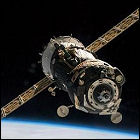 Part of the 37th full-time crew of the International Space Station lifts off from Russia’s Baikonur Cosmodrome aboard Soyuz TMA-10M. Oleg Kotov, Sergey Ryazansky and Michael Hopkins take up residence on the ISS for 166 days, becoming part of the Expedition 37/38 crews. Use of the recently developed “fast track” trajectory resumes, taking Soyuz from launch to docking at the ISS in under six hours. This crew returns to Earth in March 2014 aboard the same vehicle.
Part of the 37th full-time crew of the International Space Station lifts off from Russia’s Baikonur Cosmodrome aboard Soyuz TMA-10M. Oleg Kotov, Sergey Ryazansky and Michael Hopkins take up residence on the ISS for 166 days, becoming part of the Expedition 37/38 crews. Use of the recently developed “fast track” trajectory resumes, taking Soyuz from launch to docking at the ISS in under six hours. This crew returns to Earth in March 2014 aboard the same vehicle.
Soyuz TMA-09M
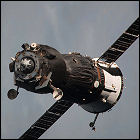 Part of the 36th full-time crew of the International Space Station lifts off from Russia’s Baikonur Cosmodrome aboard Soyuz TMA-09M. Fyodor Yurchikhin, Karen Nyberg and Luca Parmitano take up residence on the ISS for 166 days, becoming part of the Expedition 36/37 crews. Once again, a new “fast track” trajectory propels Soyuz from launch to docking at the ISS in under six hours. This crew returns to Earth in November 2013 aboard the same vehicle.
Part of the 36th full-time crew of the International Space Station lifts off from Russia’s Baikonur Cosmodrome aboard Soyuz TMA-09M. Fyodor Yurchikhin, Karen Nyberg and Luca Parmitano take up residence on the ISS for 166 days, becoming part of the Expedition 36/37 crews. Once again, a new “fast track” trajectory propels Soyuz from launch to docking at the ISS in under six hours. This crew returns to Earth in November 2013 aboard the same vehicle.
Soyuz TMA-08M
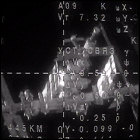 Soyuz TMA-08M lifts off from Russia, testing a new “fast track” trajectory to the International Space Station. With cosmonauts Pavel Vinogradov and Alexander Misurkin, and astronaut Chris Cassidy aboard, the Soyuz capsule reaches the Station only six hours after liftoff, as opposed to the usual two days. The three new crew members join Expedition 35.
Soyuz TMA-08M lifts off from Russia, testing a new “fast track” trajectory to the International Space Station. With cosmonauts Pavel Vinogradov and Alexander Misurkin, and astronaut Chris Cassidy aboard, the Soyuz capsule reaches the Station only six hours after liftoff, as opposed to the usual two days. The three new crew members join Expedition 35.
Soyuz TMA-07M
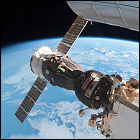 Part of the 34th full-time crew of the International Space Station lifts off from Russia’s Baikonur Cosmodrome aboard Soyuz TMA-07M. Roman Romanenko, Chris Hadfield and Thomas Marshburn take up residence on the ISS for 145 days, becoming part of the Expedition 34/35 crews. All three return to Earth in May 2013 aboard the same vehicle, with Hadfield becoming an internet sensation at the end of the mission with a cover of David Bowie’s “A Space Oddity” recorded aboard the station.
Part of the 34th full-time crew of the International Space Station lifts off from Russia’s Baikonur Cosmodrome aboard Soyuz TMA-07M. Roman Romanenko, Chris Hadfield and Thomas Marshburn take up residence on the ISS for 145 days, becoming part of the Expedition 34/35 crews. All three return to Earth in May 2013 aboard the same vehicle, with Hadfield becoming an internet sensation at the end of the mission with a cover of David Bowie’s “A Space Oddity” recorded aboard the station.
Soyuz TMA-06M
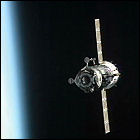 Part of the 33rd full-time crew of the International Space Station lifts off from Russia’s Baikonur Cosmodrome aboard Soyuz TMA-06M. Oleg Novitskiy, Evgeny Tarelkin and Kevin Ford take up residence on the ISS for 143 days, becoming part of the Expedition 33/34 crews. All three return to Earth in March 2013 aboard the same vehicle.
Part of the 33rd full-time crew of the International Space Station lifts off from Russia’s Baikonur Cosmodrome aboard Soyuz TMA-06M. Oleg Novitskiy, Evgeny Tarelkin and Kevin Ford take up residence on the ISS for 143 days, becoming part of the Expedition 33/34 crews. All three return to Earth in March 2013 aboard the same vehicle.
Soyuz TMA-05M
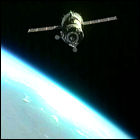 Part of the 32nd full-time crew of the International Space Station lifts off from Russia’s Baikonur Cosmodrome aboard Soyuz TMA-05M. Yuri Malenchenko, Sunita Williams and Akihiko Hoshide take up residence on the ISS for 127 days, becoming part of the Expedition 32/33 crews. All three return to Earth in November 2012 aboard the same vehicle.
Part of the 32nd full-time crew of the International Space Station lifts off from Russia’s Baikonur Cosmodrome aboard Soyuz TMA-05M. Yuri Malenchenko, Sunita Williams and Akihiko Hoshide take up residence on the ISS for 127 days, becoming part of the Expedition 32/33 crews. All three return to Earth in November 2012 aboard the same vehicle.
Soyuz TMA-04M
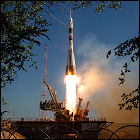 Part of the 31st full-time crew of the International Space Station lifts off from Russia’s Baikonur Cosmodrome aboard Soyuz TMA-04M. Gennady Padalka, Sergei Revin and Joseph Acaba take up residence on the ISS for 124 days, becoming part of the Expedition 31/32 crews. All three return to Earth in September 2012 aboard the same vehicle.
Part of the 31st full-time crew of the International Space Station lifts off from Russia’s Baikonur Cosmodrome aboard Soyuz TMA-04M. Gennady Padalka, Sergei Revin and Joseph Acaba take up residence on the ISS for 124 days, becoming part of the Expedition 31/32 crews. All three return to Earth in September 2012 aboard the same vehicle.
Soyuz TMA-03M
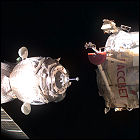 Part of the 30th full-time crew of the International Space Station lifts off from Russia’s Baikonur Cosmodrome aboard Soyuz TMA-03M. Oleg Kononenko, André Kuipers and Donald Pettit take up residence on the ISS for 194 days, becoming part of the Expedition 29/30 crews. All three return to Earth in July 2012 aboard the same vehicle.
Part of the 30th full-time crew of the International Space Station lifts off from Russia’s Baikonur Cosmodrome aboard Soyuz TMA-03M. Oleg Kononenko, André Kuipers and Donald Pettit take up residence on the ISS for 194 days, becoming part of the Expedition 29/30 crews. All three return to Earth in July 2012 aboard the same vehicle.
Soyuz TMA-22
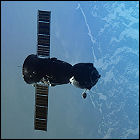 Part of the 29th full-time crew of the International Space Station lifts off from Russia’s Baikonur Cosmodrome aboard Soyuz TMA-22. Anton Shkaplerov, Anatoli Ivanishin and Daniel Burbank take up residence on the ISS for 165 days, becoming part of the Expedition 29/30 crews. All three return to Earth in April 2012 aboard the same vehicle. This was the first Soyuz mission to the International Space Station following the end of the American space shuttle program.
Part of the 29th full-time crew of the International Space Station lifts off from Russia’s Baikonur Cosmodrome aboard Soyuz TMA-22. Anton Shkaplerov, Anatoli Ivanishin and Daniel Burbank take up residence on the ISS for 165 days, becoming part of the Expedition 29/30 crews. All three return to Earth in April 2012 aboard the same vehicle. This was the first Soyuz mission to the International Space Station following the end of the American space shuttle program.
Soyuz TMA-02M
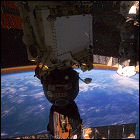 Part of the 28th full-time crew of the International Space Station lifts off from Russia’s Baikonur Cosmodrome aboard Soyuz TMA-02M. Sergey Volkov, Satoshi Furukawa and Michael Fossum take up residence on the ISS for 167 days, becoming part of the Expedition 28/29 crews. All three return to Earth in November 2011 aboard the same vehicle.
Part of the 28th full-time crew of the International Space Station lifts off from Russia’s Baikonur Cosmodrome aboard Soyuz TMA-02M. Sergey Volkov, Satoshi Furukawa and Michael Fossum take up residence on the ISS for 167 days, becoming part of the Expedition 28/29 crews. All three return to Earth in November 2011 aboard the same vehicle.
Soyuz TMA-21
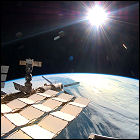 Part of the 27th full-time crew of the International Space Station lifts off from Russia’s Baikonur Cosmodrome aboard Soyuz TMA-21. Aleksandr Samokutyayev, Andrei Borisenko and Ron Garan take up residence on the ISS for 164 days, becoming part of the Expedition 27/28 crews. All three return to Earth in September 2011 aboard the same vehicle.
Part of the 27th full-time crew of the International Space Station lifts off from Russia’s Baikonur Cosmodrome aboard Soyuz TMA-21. Aleksandr Samokutyayev, Andrei Borisenko and Ron Garan take up residence on the ISS for 164 days, becoming part of the Expedition 27/28 crews. All three return to Earth in September 2011 aboard the same vehicle.
Soyuz TMA-20
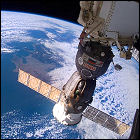 Part of the 26th full-time crew of the International Space Station lifts off from Russia’s Baikonur Cosmodrome aboard Soyuz TMA-20. Dmitri Kondratyev, Catherine Coleman and Paolo Nespoli take up residence on the ISS for 159 days, becoming part of the Expedition 26/27 crews. All three return to Earth in May 2011 aboard the same vehicle.
Part of the 26th full-time crew of the International Space Station lifts off from Russia’s Baikonur Cosmodrome aboard Soyuz TMA-20. Dmitri Kondratyev, Catherine Coleman and Paolo Nespoli take up residence on the ISS for 159 days, becoming part of the Expedition 26/27 crews. All three return to Earth in May 2011 aboard the same vehicle.
Soyuz TMA-01M
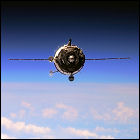 Part of the 25th full-time crew of the International Space Station lifts off from Russia’s Baikonur Cosmodrome aboard Soyuz TMA-01M. This is a newly redesigned and upgraded Soyuz vehicle, boasting fully digital navigation and automation. Aleksandr Kaleri, Oleg Skripochka and Scott Kelly take up residence on the ISS for 159 days, becoming part of the Expedition 25/26 crews. All three return to Earth in March 2011 aboard the same vehicle.
Part of the 25th full-time crew of the International Space Station lifts off from Russia’s Baikonur Cosmodrome aboard Soyuz TMA-01M. This is a newly redesigned and upgraded Soyuz vehicle, boasting fully digital navigation and automation. Aleksandr Kaleri, Oleg Skripochka and Scott Kelly take up residence on the ISS for 159 days, becoming part of the Expedition 25/26 crews. All three return to Earth in March 2011 aboard the same vehicle.
Soyuz TMA-19
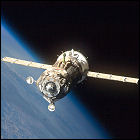 Part of the 24th full-time crew of the International Space Station lifts off from Russia’s Baikonur Cosmodrome aboard Soyuz TMA-19. Fyodor Yurchikhin, Shannon Walker and Douglas Wheelock take up residence on the ISS for 163 days, becoming part of the Expedition 24/25 crews. All three return to Earth in November 2010 aboard the same vehicle.
Part of the 24th full-time crew of the International Space Station lifts off from Russia’s Baikonur Cosmodrome aboard Soyuz TMA-19. Fyodor Yurchikhin, Shannon Walker and Douglas Wheelock take up residence on the ISS for 163 days, becoming part of the Expedition 24/25 crews. All three return to Earth in November 2010 aboard the same vehicle.
Soyuz TMA-18
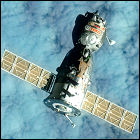 Part of the 23rd full-time crew of the International Space Station lifts off from Russia’s Baikonur Cosmodrome aboard Soyuz TMA-18. Aleksandr Skvortsov, Mikhail Korniyenko and Tracy Caldwell Dyson take up residence on the ISS for 164 days, becoming part of the Expedition 23/24 crews. All three return to Earth in September 2010 aboard the same vehicle.
Part of the 23rd full-time crew of the International Space Station lifts off from Russia’s Baikonur Cosmodrome aboard Soyuz TMA-18. Aleksandr Skvortsov, Mikhail Korniyenko and Tracy Caldwell Dyson take up residence on the ISS for 164 days, becoming part of the Expedition 23/24 crews. All three return to Earth in September 2010 aboard the same vehicle.
Soyuz TMA-17
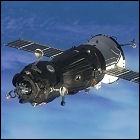 Part of the 22nd full-time crew of the International Space Station lifts off from Russia’s Baikonur Cosmodrome aboard Soyuz TMA-17. Oleg Kotov, Timothy Creamer and Soichi Noguchi take up residence on the ISS for 164 days, becoming part of the Expedition 22/23 crews. All three return to Earth in June 2010 aboard the same vehicle.
Part of the 22nd full-time crew of the International Space Station lifts off from Russia’s Baikonur Cosmodrome aboard Soyuz TMA-17. Oleg Kotov, Timothy Creamer and Soichi Noguchi take up residence on the ISS for 164 days, becoming part of the Expedition 22/23 crews. All three return to Earth in June 2010 aboard the same vehicle.
Soyuz TMA-16
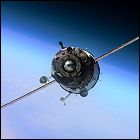 Part of the 21st full-time crew of the International Space Station lifts off from Russia’s Baikonur Cosmodrome aboard Soyuz TMA-16. Maksim Surayev and Jeffrey Williams take up residence on the ISS for 168 days, becoming part of the Expedition 21 crew. Joining them for the flight to the ISS is Canadian space tourist and Cirque de Soleil CEO Guy Laliberté, who visits the station for ten days before returning to Earth aboard Soyuz TMA-14 with members of the Expedition 19/20 crew. As with other space tourists before him, he pays for his own Soyuz seat and space training, but the impending retirement of the space shuttle fleet puts an end to Soyuz space tourism for several years after this flight.
Part of the 21st full-time crew of the International Space Station lifts off from Russia’s Baikonur Cosmodrome aboard Soyuz TMA-16. Maksim Surayev and Jeffrey Williams take up residence on the ISS for 168 days, becoming part of the Expedition 21 crew. Joining them for the flight to the ISS is Canadian space tourist and Cirque de Soleil CEO Guy Laliberté, who visits the station for ten days before returning to Earth aboard Soyuz TMA-14 with members of the Expedition 19/20 crew. As with other space tourists before him, he pays for his own Soyuz seat and space training, but the impending retirement of the space shuttle fleet puts an end to Soyuz space tourism for several years after this flight.
Soyuz TMA-15 / ISS Expedition 20
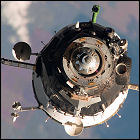 The 20th full-time crew of the International Space Station lifts off from Russia’s Baikonur Cosmodrome aboard Soyuz TMA-14. Roman Romanenko, Frank De Winne and Robert Thirsk take up residence on the ISS for 188 days, becoming half the ISS’ first six-person crew. All three crew members return about the same Soyuz capsule in December 2009.
The 20th full-time crew of the International Space Station lifts off from Russia’s Baikonur Cosmodrome aboard Soyuz TMA-14. Roman Romanenko, Frank De Winne and Robert Thirsk take up residence on the ISS for 188 days, becoming half the ISS’ first six-person crew. All three crew members return about the same Soyuz capsule in December 2009.
Soyuz TMA-14 / ISS Expedition 19
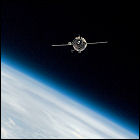 The fourteenth full-time crew of the International Space Station lifts off from Russia’s Baikonur Cosmodrome aboard Soyuz TMA-14. Gennady Padalka and Michael Barratt take up residence on the ISS for 199 days. Arriving with them on the ISS for a 12-day stay is returning space tourist Charles Simonyi, who returns to Earth aboard Soyuz TMA-13 with the Expedition 18 crew. As with his previous flight to the ISS, Simonyi pays for his own Soyuz seat and mission training.
The fourteenth full-time crew of the International Space Station lifts off from Russia’s Baikonur Cosmodrome aboard Soyuz TMA-14. Gennady Padalka and Michael Barratt take up residence on the ISS for 199 days. Arriving with them on the ISS for a 12-day stay is returning space tourist Charles Simonyi, who returns to Earth aboard Soyuz TMA-13 with the Expedition 18 crew. As with his previous flight to the ISS, Simonyi pays for his own Soyuz seat and mission training.
Soyuz TMA-13 / ISS Expedition 18
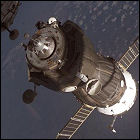 The eighteenth full-time crew of the International Space Station lifts off from Russia’s Baikonur Cosmodrome aboard Soyuz TMA-13. Yuri Lonchakov and Michael Fincke take up residence on the ISS for 199 days. Arriving with them on the ISS for a ten-day stay is space tourist and computer game mogul Richard Garriott (creator of the series of Ultima role-playing games, which feature his alter ego “Lord British” as their benevolent ruler), who returns to Earth aboard Soyuz TMA-11 with the Expedition 16 crew. Like other “space tourists” before him, Garriott pays for his own Soyuz seat and mission training. While aboard, Garriott films Apogee Of Fear, which he later calls “the first science fiction film actually filmed in space”, with the help of his crewmates; NASA later objects to the movie when it discovers that its astronauts were recruited as actors and crew. Obviously bitten by the space acting bug, Fincke would later guest star in an episode of Star Trek: Enterprise.
The eighteenth full-time crew of the International Space Station lifts off from Russia’s Baikonur Cosmodrome aboard Soyuz TMA-13. Yuri Lonchakov and Michael Fincke take up residence on the ISS for 199 days. Arriving with them on the ISS for a ten-day stay is space tourist and computer game mogul Richard Garriott (creator of the series of Ultima role-playing games, which feature his alter ego “Lord British” as their benevolent ruler), who returns to Earth aboard Soyuz TMA-11 with the Expedition 16 crew. Like other “space tourists” before him, Garriott pays for his own Soyuz seat and mission training. While aboard, Garriott films Apogee Of Fear, which he later calls “the first science fiction film actually filmed in space”, with the help of his crewmates; NASA later objects to the movie when it discovers that its astronauts were recruited as actors and crew. Obviously bitten by the space acting bug, Fincke would later guest star in an episode of Star Trek: Enterprise.
More about the Ultima games in Phosphor Dot Fossils
More about Star Trek: Enterprise in the LogBook
Soyuz TMA-12 / ISS Expedition 17
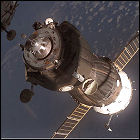 The seventeenth full-time crew of the International Space Station lifts off from Russia’s Baikonur Cosmodrome aboard Soyuz TMA-12. Sergei Volkov and Oleg Kononenko take up residence on the ISS for 199 days. Arriving with them on the ISS for a ten-day stay is South Korean astronaut Yi So-Yeon, who returns to Earth aboard Soyuz TMA-11 with the Expedition 16 crew.
The seventeenth full-time crew of the International Space Station lifts off from Russia’s Baikonur Cosmodrome aboard Soyuz TMA-12. Sergei Volkov and Oleg Kononenko take up residence on the ISS for 199 days. Arriving with them on the ISS for a ten-day stay is South Korean astronaut Yi So-Yeon, who returns to Earth aboard Soyuz TMA-11 with the Expedition 16 crew.
Soyuz TMA-11 / ISS Expedition 16
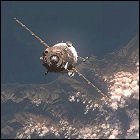 The sixteenth full-time crew of the International Space Station lifts off from Russia’s Baikonur Cosmodrome aboard Soyuz TMA-11. Yuri Malenchenko and Peggy Whitson take up residence on the ISS for 196 days. Arriving with them on the ISS for a ten-day stay is Malaysian space tourist Sheikh Muszaphar Shukor, who returns to Earth aboard Soyuz TMA-10 with the Expedition 15 crew. Like other “space tourists” before him, he has paid for his own Soyuz seat and mission training. When Malenchenko and Whitson return in April 2008 with South Korean astronaut Yi So-Yeon, the Soyuz suffers a dangerous malfunction, failing to jettison its service module; the result is an off-balance spacecraft that re-enters the atmosphere nose-first, exposing under-insulated portions of the vehicle to the heat of re-entry and forcing the crew to endure 10 Gs. The vehicle lands nearly 300 miles off-course and Yi So-Yeon suffers neck and spinal injuries in the landing; the head of the Russian space program doesn’t improve matters by blaming these events on an “old Russian superstition” that having more women than men in a vehicle is bad luck. NASA and Russian space engineers begin investigating the mishap, finally arriving at the more plausible explanation of a malfunctioning spacecraft.
The sixteenth full-time crew of the International Space Station lifts off from Russia’s Baikonur Cosmodrome aboard Soyuz TMA-11. Yuri Malenchenko and Peggy Whitson take up residence on the ISS for 196 days. Arriving with them on the ISS for a ten-day stay is Malaysian space tourist Sheikh Muszaphar Shukor, who returns to Earth aboard Soyuz TMA-10 with the Expedition 15 crew. Like other “space tourists” before him, he has paid for his own Soyuz seat and mission training. When Malenchenko and Whitson return in April 2008 with South Korean astronaut Yi So-Yeon, the Soyuz suffers a dangerous malfunction, failing to jettison its service module; the result is an off-balance spacecraft that re-enters the atmosphere nose-first, exposing under-insulated portions of the vehicle to the heat of re-entry and forcing the crew to endure 10 Gs. The vehicle lands nearly 300 miles off-course and Yi So-Yeon suffers neck and spinal injuries in the landing; the head of the Russian space program doesn’t improve matters by blaming these events on an “old Russian superstition” that having more women than men in a vehicle is bad luck. NASA and Russian space engineers begin investigating the mishap, finally arriving at the more plausible explanation of a malfunctioning spacecraft.